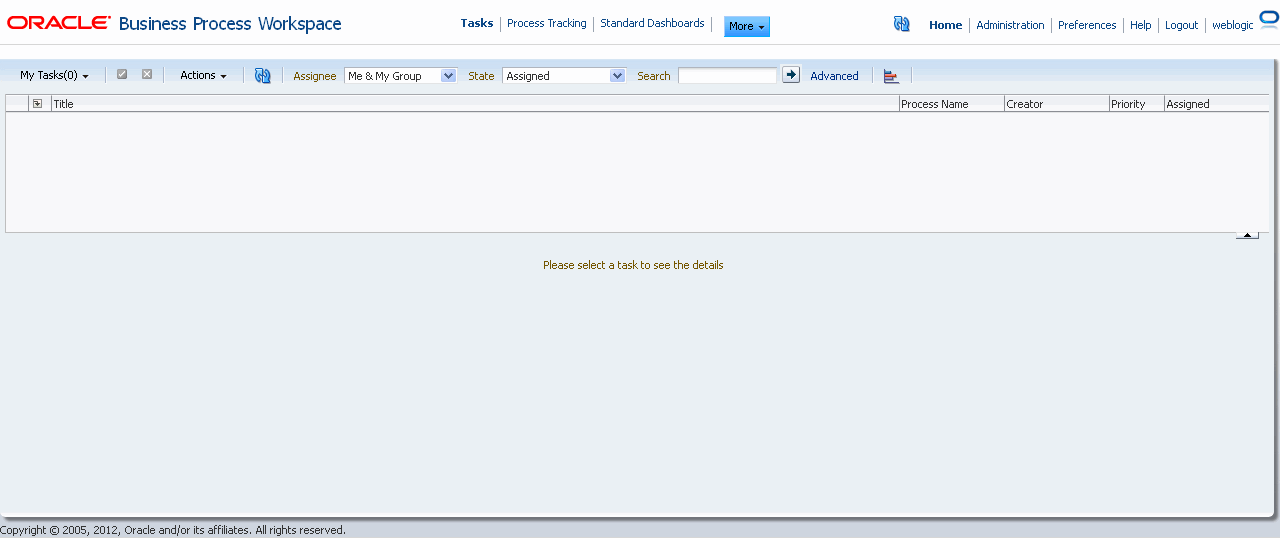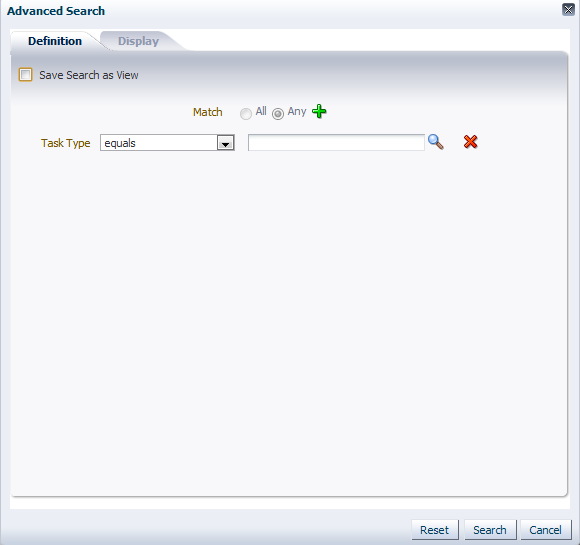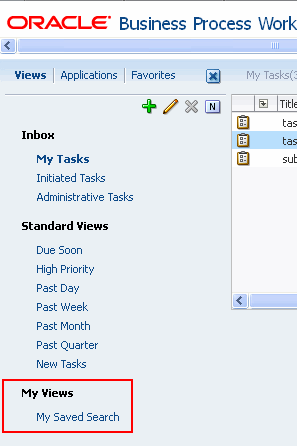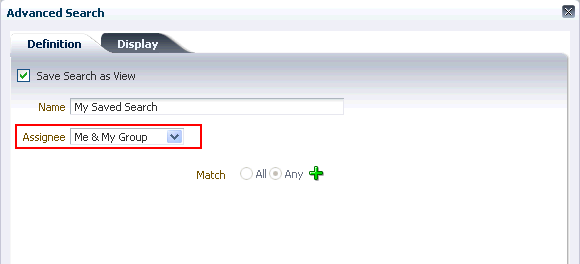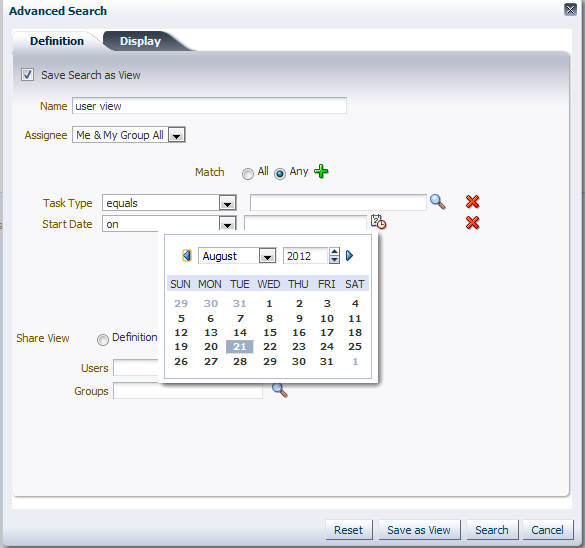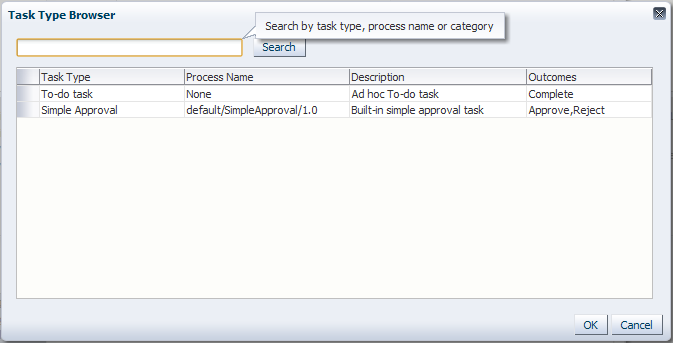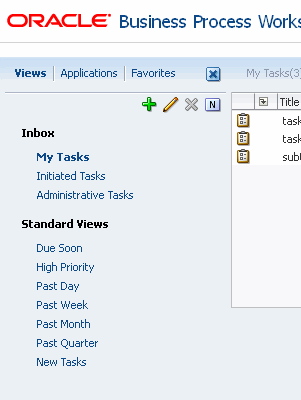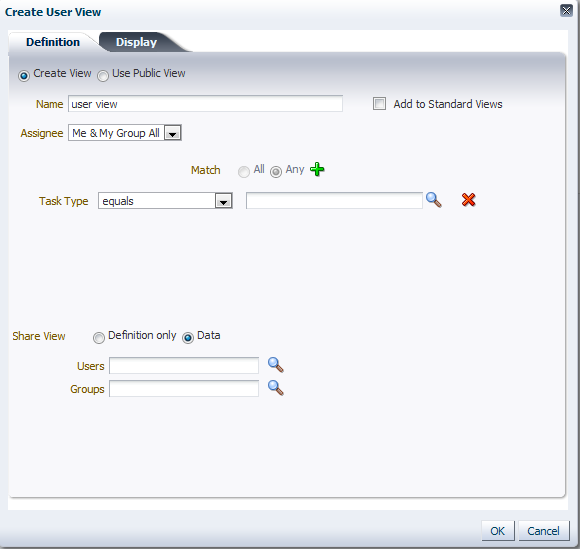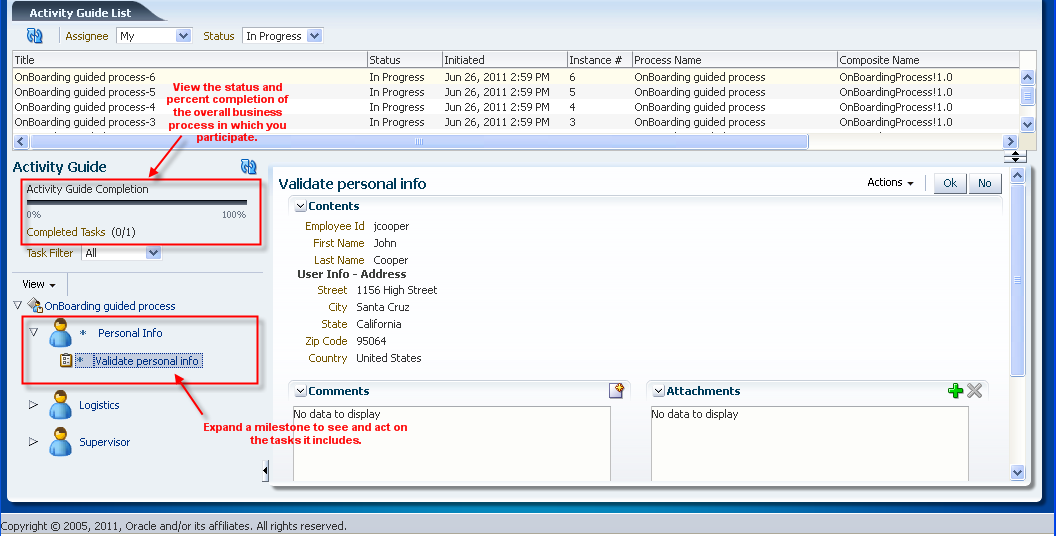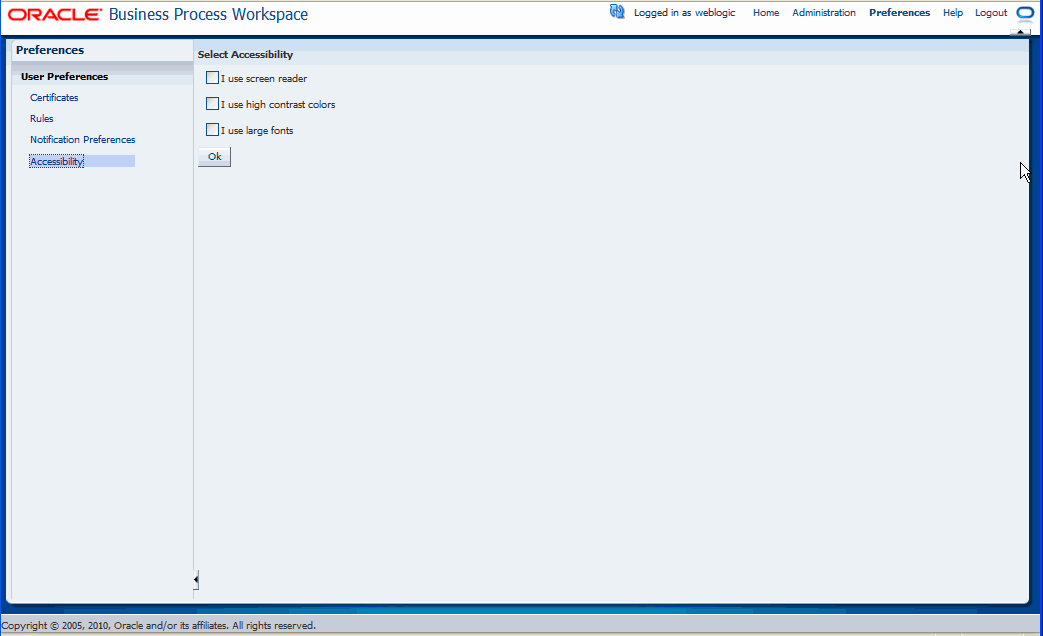1 Getting Started with Process Workspace
This chapter tells you how to start and log in to Process Workspace, navigate its interface, and configure your preferences.
Process Workspace is a customizable web-based interface enabling users to access and manage tasks and process instances according to their roles and responsibilities.
To help you get started with Process Workspace, this chapter contains these topics:
-
Section 1.4, "Setting Accessibility Preferences in Process Workspace"
-
Section 1.5, "Providing a Digital Certificate in Process Workspace"
-
Section 1.7, "Setting Your Preferences in Process Workspace"
For information about troubleshooting human workflow issues, see Oracle Fusion Middleware Administrator's Guide for Oracle SOA Suite and Oracle Business Process Management Suite, "Human Workflow Troubleshooting".
1.1 Understanding Process Workspace
Table 1-1 lists and describes the users for whom Process Workspace is designed.
Table 1-1 Users of Oracle Business Process Management Workspace
| User Profile | Description |
|---|---|
|
Process Participants |
This is the most basic profile, common to all users. It enables you to:
These users may be spread throughout the organization or work outside the company. A process participant may be one who not only initiates the process, but can also track its progress and, if appropriate, withdraw it. |
|
Process Owners |
Users who manage one or more business process. They act on tasks belonging to the process but assigned to other users, in addition to their own end-user access. They want to know how process instances are moving in those processes. To get this perspective, they typically use dashboards. These users usually reside on the business side of the house as part of the operations organization. They may also be supervisors. |
|
Administrators |
Includes two types of administrative users:
|
|
Supervisors |
Users with other process participants reporting to them. To ensure that process instances execute as expected, supervisors can:
|
Process analysts typically use the Oracle Business Process Analysis Suite or Business Process Composer to create process models. They can also use the process analyst role within Oracle BPM Studio.
Process developers typically use Oracle BPM Studio to model and implement the components of a business application. They may occasionally use Business Process Composer for modeling basic processes.
1.2 Starting and Logging In to Process Workspace
To start Process Workspace, you must have installed Oracle SOA Suite, and the Service Integration server must be running. See your installation documentation for more information.
To start and log into Process Workspace:
-
Go to
http://host_name:port_number/bpm/workspace/The
host_nameis the name of the host computer on which Oracle SOA Suite is installed.The
port_numberis the one used at installation. -
Enter the user name and password.
You can use the preseeded user name to log in as an administrator. If you have loaded the demo user community in the identity store, then you can use other users such as jstein or jcooper.
The user name and password must exist in the user community provided to JAZN.
-
Click Login.
Notes:
-
If you expect to have a large number of users using Process Workspace simultaneously, then set the session time-out value to no more than 5 minutes. To do this, expand the Process Workspace
.earfile, open theweb.xmlfile, and update the time-out parameter. -
If user identities are stored in Microsoft Active Directory, then at times authentication can fail because Oracle WebLogic Server, where Process Workspace is running, cannot communicate with the Active Directory installation. This can occur when Oracle WebLogic Server and Active Directory are in separate domains.
To resolve this issue, add the entry for the Active Directory host's address to the
/etc/hostsfile on machine where Process Workspace is running.
1.3 Navigating Process Workspace
Figure 1-1 shows an example of Process Workspace Home page as it appears by default when you log in.
Figure 1-1 Example of Process Workspace Home
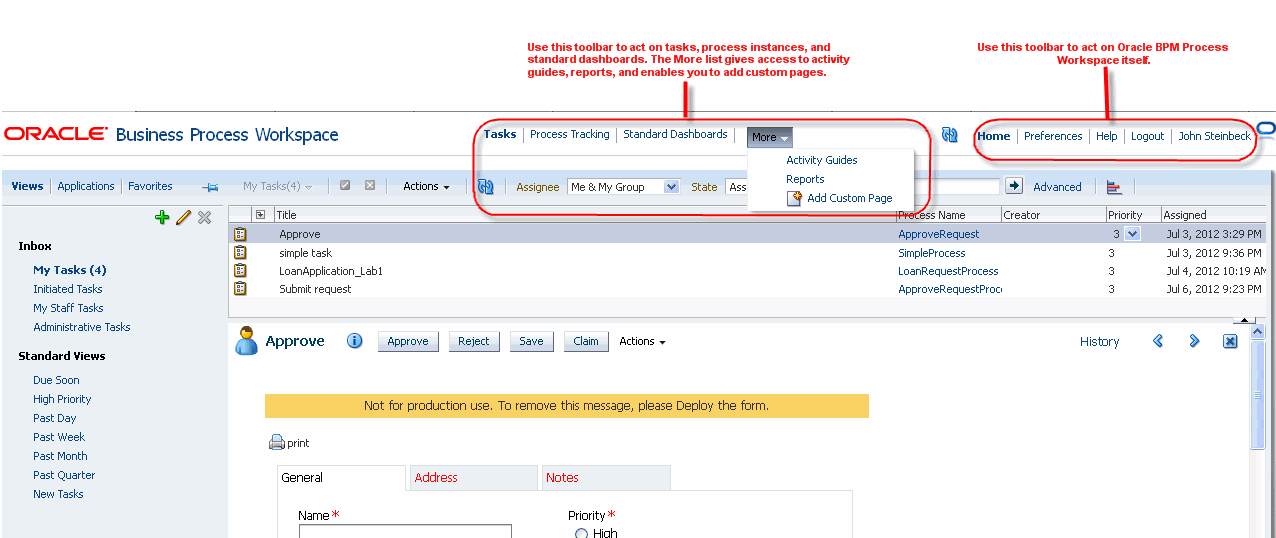
Description of "Figure 1-1 Example of Process Workspace Home"
At the very top, you see two toolbars. You use the top-center toolbar to act on tasks, process instances, dashboards, activity guides, reports, and to add custom pages. The links to these parts of Process Workspace are listed and described in Table 1-2.
Table 1-2 Toolbar for Tasks, Activity Guides, Process Instances, Dashboards, and More
| Toolbar Link | Description |
|---|---|
|
Tasks |
The Tasks page displays tasks for the user based on the user's permissions and assigned groups and roles. |
|
Process Tracking |
The Process Tracking page enables you to interact with business processes based on the roles assigned to you. |
|
Standard Dashboards |
Dashboards provide analytical information to monitor process execution as well as user workloads. They provide summary information and enable you to drill down to instance-specific information. |
|
More: Reports |
|
The toolbar at the top right is for configuring and acting on Process Workspace itself—for example, logging out, and setting user preferences. If you are an administrator, then an Administration link also appears. Administrative tasks can include choosing to show or hide the default tabs, or specifying which tab page is displayed by default when the user logs in.
Table 1-3 describes the pages you access through the Home, Administration, and Preferences links.
Table 1-3 Toolbar for Oracle Business Process Management Workspace
| Page | Description |
|---|---|
|
Home |
As described in Table 1-2, the logged-in user's list of tasks, details for a selected task, and all the functions needed to start acting on a task are provided. |
|
Administration |
The following administrative functions are available:
|
|
Preferences |
Preference settings include:
|
For more information about creating custom pages, see Chapter 5, "Creating and Editing Custom Pages in Process Workspace".
For information on specifying, showing, and hiding default tabs, see Section 9.2.10, "How to Specify, Show, or Hide the Default Tab Pages in Process Workspace".
This section contains these topics:
-
Section 1.3.2, "About the Process Workspace Activity Guides Page"
-
Section 1.3.3, "About the Process Workspace Process Tracking Page"
-
Section 1.3.4, "About the Process Workspace Standard Dashboards Page"
1.3.1 About the Process Workspace Tasks Page
After a user logs in, the Home page displays the My Tasks page by default.
You can configure Process Workspace to display another page when a user logs in. This is explained in Section 9.2.10, "How to Specify, Show, or Hide the Default Tab Pages in Process Workspace".
The Tasks page displays tasks for the user based on the user's permissions and assigned groups and roles.
The Tasks page enables you to do the following:
-
Perform authorized actions on tasks in the worklist, acquire and check out shared tasks, define personal to-do tasks, and define subtasks.
-
Filter tasks in a worklist view based on various criteria.
-
Work with standard work queues, such as high priority tasks, tasks that are due soon, and so on. Work queues enable users to create a custom view to group a subset of tasks in the worklist—for example, high priority tasks, tasks due in 24 hours, expense approval tasks, and more.
-
Define custom work queues.
-
Gain proxy access to part of another user's worklist.
-
Define custom vacation rules and delegation rules.
-
Enable group owners to define task dispatching rules for shared tasks.
-
Collect a complete workflow history and audit trail.
-
Use digital signatures for tasks.
-
Display a pop-up showing details about the process instance related to this task
-
The admin can map the task outcomes of all the task types (approve, reject, complete, resolve, etc.) to the images available through the workflow global configuration in Enterprise Manager. After mapping the task outcome to the images, you can take task outcome actions from the worklist task list tool bar by clicking on the available images.
Note:
If you change a user's privileges in Fusion Middleware Control Console while the user is logged in to Process Workspace, the changes take effect only after a subsequent login by the user. This is true for situations in which there are two active worklist sessions: one in which the user is logged in before the privileges are changed, and another in which the same user logs in after the privileges are changed. In the first case, the changes to the user's privileges do not take effect while the user is logged in. In the second case, when the user logs in to the second instance of Process Workspace, the changes to the user's privileges do take effect.
1.3.1.1 Navigating the Process Workspace Tasks Page
Figure 1-2 shows a sample Process Workspace tasks page as it appears by default when a user first logs in.
This page lists all the tasks and work items assigned to you, depending on your role.
At the far left is a list with My Tasks selected. Expand this list to select:
-
A particular view showing the number of open tasks for each view. Selecting a particular view refreshes the task count to the latest number.
-
A list of applications deployed to Process Workspace
-
Any favorite links or applications you may have specified
To keep this list visible while you work on tasks, click Pin. To hide it, click Unpin.
Table 1-4 lists and describes the items in the list of views, applications, and favorites.
Table 1-4 Views, Applications, and Favorites List
| Component | Description |
|---|---|
|
Views |
The items displayed in the inbox depend on the role granted to the logged-in user.
|
|
Applications |
The processes the user is authorized to initiate. This component enables you to search for the authorized applications. |
|
Favorites |
Links to external websites or applications you may have specified. For more information, see Section 9.2.8, "How to Enable Customized Applications and Links in Process Workspace". |
In addition to the Views, Applications, and Favorites list, the My Tasks page includes other components listed and described in Table 1-5.
Table 1-5 Components of the Tasks Page
| Component | Description |
|---|---|
|
Display Filters |
Specify search criteria from the Search, Assignee, or Status fields. The category filters available depend on which view is selected.
You can perform an advanced search using several other criteria. For more information about searches, see Section 1.3.1.4, "Searching for Tasks in Process Workspace". |
|
Actions List |
Select a group action (Claim) or a custom action (for example, Approve or Reject) that was defined for the human task. Claim appears for tasks assigned to a group or multiple users; one user must claim the task before it can be worked. Other possible actions for a task, such as system actions, are displayed on the Task Details page for a specific task. You can also create ToDo tasks and subtasks here. When you select an action from Actions, a comment window appears. You must enter a comment and click OK to update the task and refresh the task list table. Click Cancel to cancel the action. |
|
Task Status |
A bar chart shows the status of tasks in the current view. |
|
Default Columns |
Title—The title specified when the human task was created. Tasks associated with a purged or archived process instance do not appear. Process Name—If this task is associated with a running process instance, the name of that instance. Clicking this link opens a pop-up with process details. Creator—The user who created the task. For business user tasks, the creator field shows as null. Priority—The priority specified when the human task was created. The highest priority is 1; the lowest is 5. Assigned—The date that the task was assigned. |
|
Task Details |
Task details can be viewed in the lower half of the worklist by selecting the task in the Inbox. You can also view them in a pop-up browser window by double-clicking the task. Buttons on the Task Details page indicate available actions. Once you complete a task:
|
1.3.1.2 Using the Process Workspace Task Details Page
Figure 1-3 shows an example of a Task Details page. This page is invoked by selecting a task from the inbox on the Process Workspace Tasks page. You can also view it in a pop-up browser window by double-clicking the task.
The Task Details page may appear differently depending on the tool used during design time to develop the task form it displays.
Figure 1-3 Example of a Task Details Page
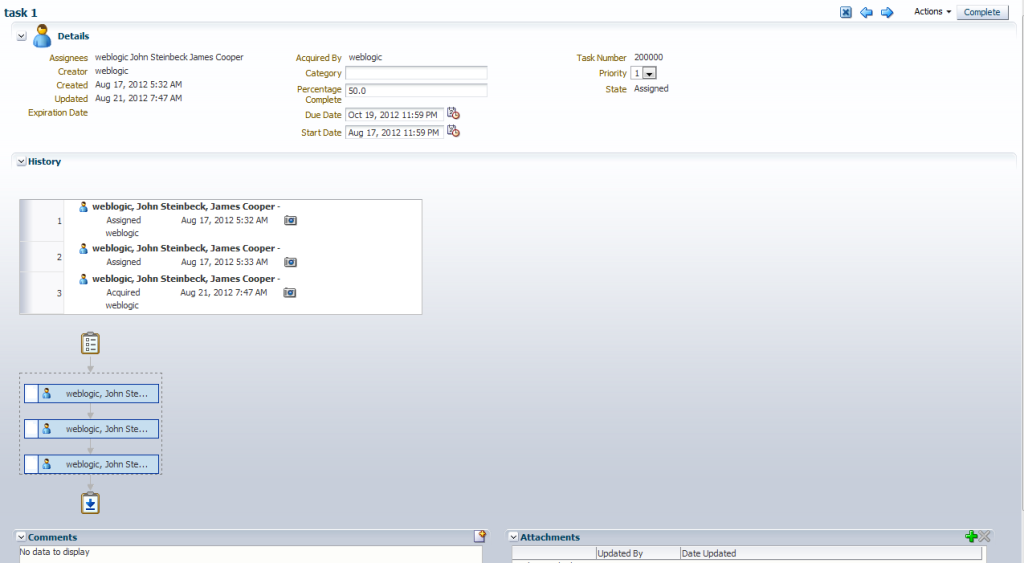
Description of "Figure 1-3 Example of a Task Details Page"
The task details page has the following components:
-
Basic information including the title of the task—for example, task 1—task number, creator, assignees, state, created date, the person who acquired the task, priority, expiration date, and other flex fields.
-
Previous Task/Next Task icons—For moving from one task to the previous or next task in the task list.
-
Action buttons—For custom actions defined for this human task during design time—for example, Resolved and Unresolved for a help desk request, or Approve and Reject for a loan request. Once you complete your role in a task, for example, by making an approval, the task list refreshes accordingly and moves you to the next task in the task list.
For the administrator, the task initiator, or the manager, Withdraw may also appear.
The available task actions depend on the user role and the task. The task actions do not depend on the which view you have selected.
-
Other Actions—System task actions, beyond the custom actions defined for the task—as described in Section 1.3.1.2.2, "Performing System Actions in Process Workspace".
-
Content—The payload. The fields displayed are specific to how the human task was created during design time.
-
History Details—These are described in Section 1.3.1.2.1, "Task History.".
-
Comments and Attachments:
-
Comments entered by various users who have participated in the workflow. A newly added comment and the commenter's user name are appended to the existing comments. A trail of comments is maintained throughout the life cycle of the task. To add a comment, you must have permission to update the task.
For information about how to add a comment, see Section 2.4, "Adding Comments and Attachments to Tasks in Process Workspace"
-
Attachments are documents or reference URLs associated with a task. These are typically associated with the workflow as defined in the human task during design time, or attached and modified by any of the participants using the task list. To add or delete an attachment, you must have permission to update the task. When adding file attachments, you can use an absolute path name or browse for a file.
-
1.3.1.2.1 Task History
The task history maintains an audit trail of the actions performed by the participants in the workflow and a snapshot of the task payload and attachments at various points in the workflow. The short history for a task lists all versions created by the following tasks:
-
Initiate task
-
Reinitiate task
-
Update outcome of task
-
Completion of task
-
Erroring of task
-
Expiration of task
-
Withdrawal of task
-
Alerting of task to the error assignee
You can include the following actions in the short history list by modifying the shortHistoryActions element.
-
Acquire
-
Ad hoc route
-
Auto release of task
-
Delegate
-
Escalate
-
Information request on task
-
Information submit for task
-
Override routing slip
-
Update outcome and route
-
Push back
-
Reassign
-
Release
-
Renew
-
Resume
-
Skip current assignment
-
Suspend
-
Update
The history provides a graphical view of a task flow, as shown in Figure 1-4.
Table 1-6 describes the icons used in the History section.
Table 1-6 Icons for Task History
| Icon | Description |
|---|---|
|
Indicates an approver in an ad hoc routing scenario. |
|
|
Indicates that the task has been approved |
|
|
Indicates that the participant just receives a notification task and the business process does not wait for the participant's response. Participant cannot directly impact the outcome of a task, but in some cases can provide comments or add attachments. |
|
|
Indicates that a set of people must work in parallel. This pattern is commonly used for voting. |
|
|
Indicates that the participant belongs to a management chain. |
|
|
Indicates the simple case in which a participant maps to a user, group, or role. |
|
|
Indicates that the task is untouched |
|
|
Indicates the end of the task flow. |
Note:
The history of a parent task also displays the history of any subtasks it contains.
1.3.1.2.2 Performing System Actions in Process Workspace
Once you have selected a task from the task list, the Actions list of the Task Details page displays system actions available on all tasks based on the user's privileges. Table 1-7 lists system actions.
| Action | Description |
|---|---|
|
Claim |
Use this action to claim a task that is assigned to a group or multiple users. Claim is the only action available in the Task Action list for group or multiuser assignments. After a task is claimed, all applicable actions are listed. |
|
Reassign |
Use this action to assign a task to someone else. If you are a manager, you can delegate a task to reportees. A user with BPMWorkflowReassign privileges can delegate a task to anyone. |
|
Escalate |
Use this action to escalate a task that is assigned to a group or multiple users. You can add an optional comment in the comments area. The task is reassigned to whomever is specified by the administrator. If no escalation path is specified, then the task is escalated to your manager (up one level in a hierarchy). |
|
Release |
Use this action to release a claimed task. If a task is assigned to a group or multiple users, it can be released if the user who claimed the task cannot complete the task. Any of the other assignees can claim and complete the task. |
|
Suspend and Resume |
Use these actions to suspend or restart a task. These options are available only to users who have been granted the BPMWorkflowSuspend role. Other users can access the task by selecting Previous in the task filter or by looking up tasks in the Suspended status. A suspension is indefinite. It does not expire until Resume is used to resume working on the task. |
|
Withdraw |
Use this action to cancel a task. If you are the creator of a task and do not want to continue with it, for example, you want to cancel a vacation request, you can withdraw it and add an optional comment in the Comments area. The business process determines what happens next. You can use the Withdraw action on the home page by using the Creator task filter. |
|
Pushback |
Use this action to send a task down one level in the workflow to the previous assignee. |
|
Renew |
Use this task to extend a task's expiration date. You can add an optional comment in the comments area. The task expiration date is extended 1 week. A renewal appears in the task history. The renewal duration for a task can be controlled by an optional parameter. The default value is |
|
Submit Information and Request Information |
Use these actions if another user requests that you supply more information or to request more information from the task creator or any of the previous assignees. If reapproval is not required, then the task is assigned to the next approver or the next step in the business process. |
For more information about the Task Details page, see Section 1.3.1.2, "Using the Process Workspace Task Details Page"
1.3.1.3 Customizing the Task List in Process Workspace
You can customize your task list in several ways, including adding worklist views, selecting which columns to display, setting the sorting order, and displaying a subset of the tasks based on filter criteria. You can customize your inbox view as well as any other view including views you have created yourself.
To increase the number of tasks retrieved, resize the task list display area.
This section contain these topics:
1.3.1.3.1 How to Filter Tasks
Figure 1-5 shows the filter fields.
Figure 1-5 Filters: Assignee, Status, Search, and Advanced Search

Description of "Figure 1-5 Filters: Assignee, Status, Search, and Advanced Search "
Filters are used to display a subset of tasks and can be applied to your inbox view or other views. Filters are based on the following criteria:
-
Assignee
Select one of the following:
-
Me: Retrieves tasks directly assigned to the logged-in user
-
My Group: Retrieves the following:
-
Tasks that are assigned to groups to which the logged-in user belongs
-
Tasks that are assigned to an application role that the logged-in user is assigned
-
Tasks that are assigned to multiple users, one of which is the logged-in user
-
-
Me & My Group: Retrieves all tasks assigned to the user, whether through direct assignment, or by way of a group, application role, or list of users
-
Me (Previously): Retrieves tasks that the logged-in user has updated
-
Me (Review Only): Retrieves task for which the logged-in user is a reviewer
From the Initiated Tasks page, select Creator.
From the My Staff Tasks page, select Reportees.
From the Administrative Tasks page, select Admin.
-
-
State: Select from the following: Any, Assigned, Completed, Suspended (can be resumed later), Withdrawn, Expired, Errored (while processing), Alerted, or Information Requested.
-
Search: Enter a keyword to search task titles, comments, identification keys, and the flex string fields of tasks that qualify for the specified filter criterion.
-
Advanced: Provides additional search filters.
Note:
If a task is assigned separately to multiple reportees, when a manager looks at the My Staff Tasks list, the manager sees as many copies of that task as the number of reportees to whom that task is assigned.
To filter tasks based on assignee or state:
Select options from the Assignee and State lists. The task list is automatically updated based on the filter selections.
To filter tasks based on keyword search:
-
Enter a keyword to search task titles, comments, identification keys, and the flex string fields of tasks that qualify for the specified filter criterion.
-
Press Enter or click Refresh.
To filter tasks based on an advanced search:
Mapped attribute labels can be used in an advanced search if you select task types for which mapped attribute have been defined.
See Section 9.4.1, "How to Specify Mapped Attributes" for more information.
-
Click Advanced.
-
(Optional) Select Save As View, provide a view name, and use the Display page to provide other information, as shown in Figure 1-6 and Figure 1-7. If you do not select Save As View, the Display page is not available and the Definition page is as seen in Figure 1-8.
Note:
Selecting Save As View creates a customized view. The saved view appears under My Views.
Figure 1-6 Worklist Advanced Search: Definition Page
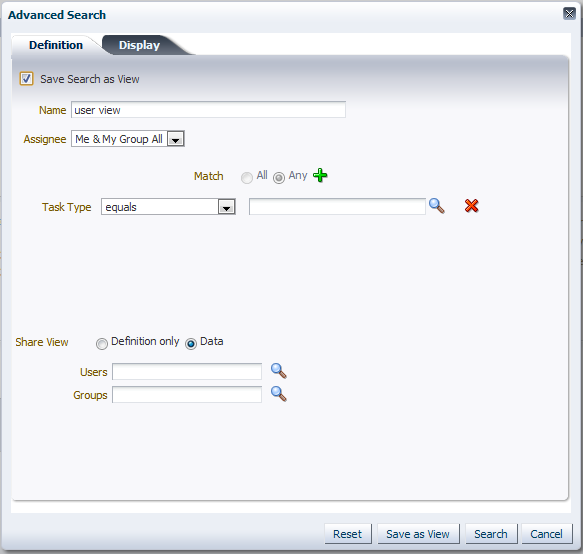
Description of "Figure 1-6 Worklist Advanced Search: Definition Page"
Figure 1-7 Worklist Advanced Search: Display Page
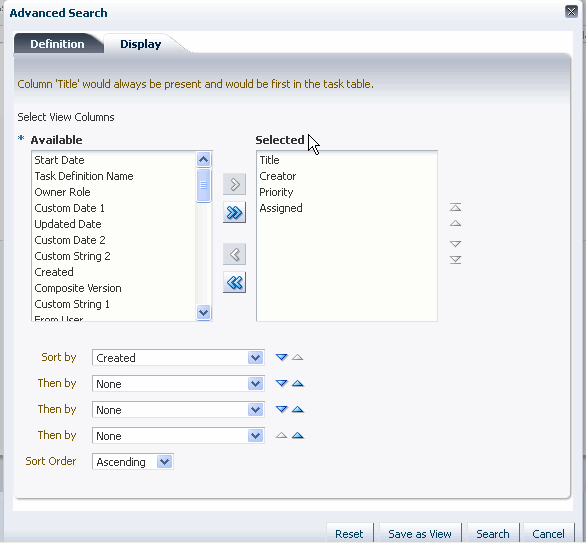
Description of "Figure 1-7 Worklist Advanced Search: Display Page"
Table 1-8 describes the advanced search view columns available in the Display page.
Note:
The titles: User Conditions, Advanced Condition, Time Conditions, Basic Conditions and Custom Conditions correspond to the menu categories for adding conditions (see Figure 1-11).
The saved view appears in the Views panel under My Views, as shown in Figure 1-9.
-
Select an assignee, as shown in Figure 1-10.
-
Select Any or All for matching multiple filters.
-
Add conditions (filters), as shown in Figure 1-11.
Figure 1-11 Adding Filters for an Advanced Search on Tasks
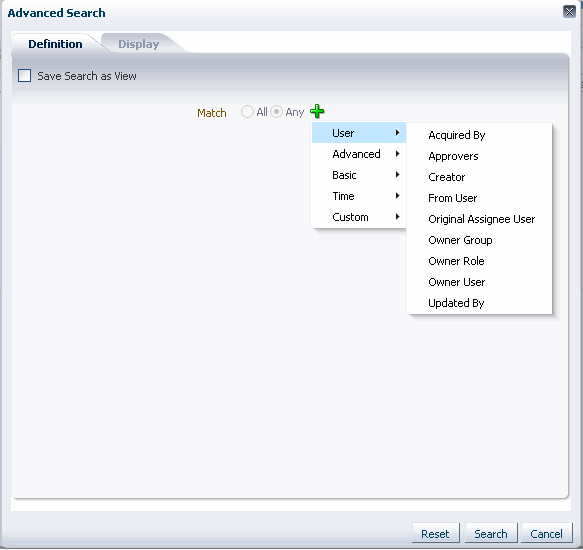
Description of "Figure 1-11 Adding Filters for an Advanced Search on Tasks"
Table 1-8 describes the available conditions.
Table 1-8 Advanced Search: Conditions
Condition Description User Conditions
Acquired By
The name of the user who claimed the task in the case when the task is assigned to a group, application role, or to multiple users, and then claimed by the user.
Approvers
The approvers of the task.
Assignees
The assignees of the task.
Creator
The name of the creator of the task.
From User
The from user for the task.
Original Assignee User
The name of the user who delegated the task in the case when the user delegates a task to another user.
Owner Group
The group (if any) that owns the task instance. Task owners can be application roles, users, or groups. If the owner of the task is a group, this field is set.
Owner Role
The application role (if any) that owns the task instance. Task owners can be application roles, users, or groups. If the owner of the task is an application role, this field is set.
Owner User
The user (if any) that owns the task instance. Task owners can be application roles, users, or groups. If the owner of the task is a user, this field is set.
Updated By
The user who last updated the task.
Advanced Conditions
Application Context
The application to which any application roles associated with the tasks (such as assignees, owners, and so on) belong.
Component
The name of the task component that defines the task instance.
Composite
The name of the composite that contains the task component that defines the task instance.
Composite Distinguished Name
The unique name for the particular deployment of the composite that contains the task component that defines the task instance.
Composite Version
The version of the composite that contains the task component that defines the task instance.
Partition
The domain to which the composite that contains the task component that defines the task instance belongs.
Task Display URL
The URL to display the details for the task.
Basic Conditions
Category
The category of the task.
Identifier
The (optional) custom unique identifier for the task. This is an additional unique identifier to the standard task number.
Number
An integer that uniquely identifies the task instance.
Outcome
The outcome of the task, for example approved or rejected. This is only set on completed task instances.
Percentage Complete
The percentage of the task completed (used with ToDo tasks).
Priority
An integer that defines the priority of the task. A lower number indicates a higher priority; typically numbers 1 to 5 are used.
State
The state of the task instance.
Task Definition Name
The name of the task component that defines the task instance.
Task Type
The type of the task.
Title
The title of the task.
Time Conditions
Assigned
The date that this task was assigned.
Created
The date that the task instance was created.
Due Date
The due date of the task (used with ToDo tasks).
End Date
The end date of the task (used with ToDo tasks).
Expires
The date on which the task instance expires.
Start Date
The start date of the task (used with ToDo tasks).
Updated Date
The date that the task instance was last updated.
Custom Conditions
Custom Date 1
Custom flex field 1 with Date datatype
Custom Date 2
Custom flex field 2 with Date datatype
Custom String 1
Custom flex field 1 with String datatype
Custom String 2
Custom flex field 2 with String datatype
Custom Number 1
Custom flex field 1 with Number datatype
Custom Number 2
Custom flex field 2 with Number datatype
-
Add parameter values as exemplified in Figure 1-12.
-
Browse for a task type or leave the field blank for all types. Mapped attribute labels can be selected in the query and display columns dialog boxes if the selected task types have mapped attribute mappings defined. Use the search option to search by task type, process name or category as shown in Figure 1-13.
-
Specify whether to share either this view's definition or its data, and the users or groups to share it with.
-
Click Search.
The task list appears with the tasks filtered according to your criteria.
1.3.1.3.2 How to Create and Customize Worklist Views
The Views menu, shown in Figure 1-14, displays your inbox, standard views, and any custom views you have created. Use it to create, share, and customize views.
-
In the Views section, click Add View. The Create User View dialog box appears as shown in Figure 1-15
-
Use the Definition page of the Create User View dialog box to do the following:
-
Create View or Use Public View—Create your own view or browse for a public view to copy.
-
Name—Specify a name for your view.
-
Add to Standard Views—This option applies to administrators only. Administrators select this option to create the view as a standard view, which then appears in the Standard Views list for all worklist users.
-
Assignee—Select Me, My Group, Me & My Group, Me & My Group All, Me (Previously), Reviewer, Creator, Reportees, Admin, Owner
-
Add Condition—Select a filter from the list and click Add. For example, if you select startDate, and click Add, then a calendar and a list including on, equals, not equals, greater than, less than, and so on appears.
-
Match—Select All or Any to match the conditions you added.
-
Task Type—Browse for a task type or leave the field blank for all types. Mapped attribute labels can be selected in the query and display columns dialog boxes if the selected task types have mapped attribute mappings defined.
-
Share View—You can grant access to another user to either the definition of this view, in which case the view conditions are applied to the grantee's data, or to the data itself, in which case the grantee can see the grantor's worklist view, including the data. Sharing a view with another user is similar to delegating all tasks that correspond to that view to the other user; that is, the other user can act on your behalf. Shared views are displayed under My Views.
-
Assignees—Specify the users (grantees) who can share your view.
-
-
Use the Display page of the Create User View dialog box, shown in Figure 1-16, to customize the fields that appear in the view.
Figure 1-16 Displaying Fields in a Worklist View
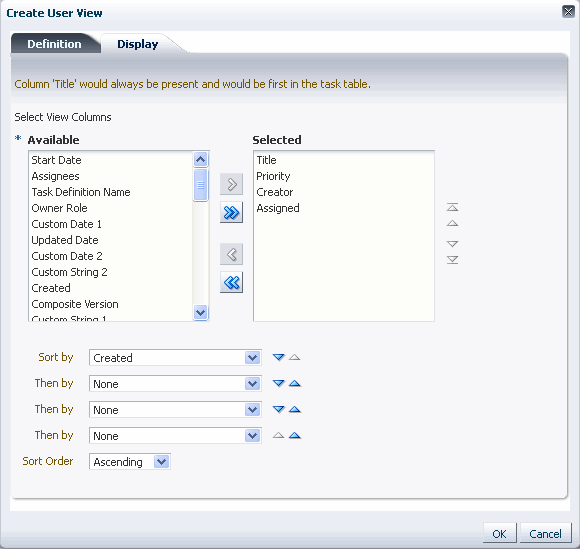
Description of "Figure 1-16 Displaying Fields in a Worklist View"
-
Select View Columns—Specify which columns you want to display in your task list. They can be standard task attributes or mapped attributes that were mapped for the specific task type. The default columns are the same as the columns in your inbox.
-
Sort by —Select a column or multiple columns on which to sort. Use the arrow buttons to specify the preferred sequence.
-
Sort Order—Select ascending or descending order.
The sorting options selected are saved as a user preference.
-
-
Click OK.
The saved view appears in the Views panel under My Views.
Note:
If you select to display the Task Display URL column, you must have an associated taskflow for the deployed task. The taskflow registration is performed during deployment. At that time, the Task Display URL column value is set. If the taskflow is not associated during deployment, the Task Display URL column does not display generic URL details for a task.
-
In the Views, Applications, and Favorites pane, select Views, then select the view you want to customize.
-
Select Edit User Preferences. The Edit User Preferences dialog box appears as shown in Figure 1-17.
Figure 1-17 Customizing Fields in a Worklist View

Description of "Figure 1-17 Customizing Fields in a Worklist View"
-
Use the Edit User Preferences dialog box to customize the view.
When you select and move items from the Available Columns list to the Selected Columns list (or vice-versa), the items remain selected. Therefore, if you select items to move back, the previously selected items are also moved. Ensure that you deselect items after moving them between the lists if you intend to move additional columns.
To specify the number of tasks to display in the view, set the number in the Number of tasks per fetch list.
To hide the details panel so that it appears only when you select a task, select Hide Task Details Panel.
To specify how the Task Details Panel appears, in the Display task details in field, select either External Window or Same Window.
To specify which language settings to use, in the Use Language Settings of field, select either Browser or Identity Provider. For more information about specifying language, see Section 9.2.3, "How to Specify the Language Locale Information in Process Workspace".
When you have finished making your settings, click OK.
1.3.2 About the Process Workspace Activity Guides Page
Activity guides organize your tasks into milestones. Each milestone is a specific set of tasks for you to complete, either on your own or in collaboration with others. For each milestone, the activity guide tells you which tasks to complete and in which order. You complete a milestone by completing all the tasks it contains for you. Depending on the nature of the task, you can save an unfinished task and resume it later.
Figure 1-18 shows an example of an activity guide.
Using an activity guide, you can:
-
Expand a milestone to see and act on the tasks it includes.
-
View the status and percent completion of the overall business process in which you participate.
For more information about navigating the Activity Guides page, see Section 4.2, "Navigating Activity Guides".
1.3.3 About the Process Workspace Process Tracking Page
Use the Process Tracking page to interact with business processes based on the roles assigned to you.
Using the Process Tracking tab, you can do the following:
-
View the list of process instances pending in your inbox.
-
Execute tasks. That is, carry out a human task on a particular instance.
-
Search for instances by different criteria.
-
Save the searches as a view.
-
View the details of an instance, including the audit trail.
-
Create a new instance, if you have permission to do so.
-
Attach a file to an instance.
-
Add notes to an instance.
1.3.3.1 Navigating the Process Workspace Process Tracking Page
Figure 1-19 Process Workspace Process Tracking Page
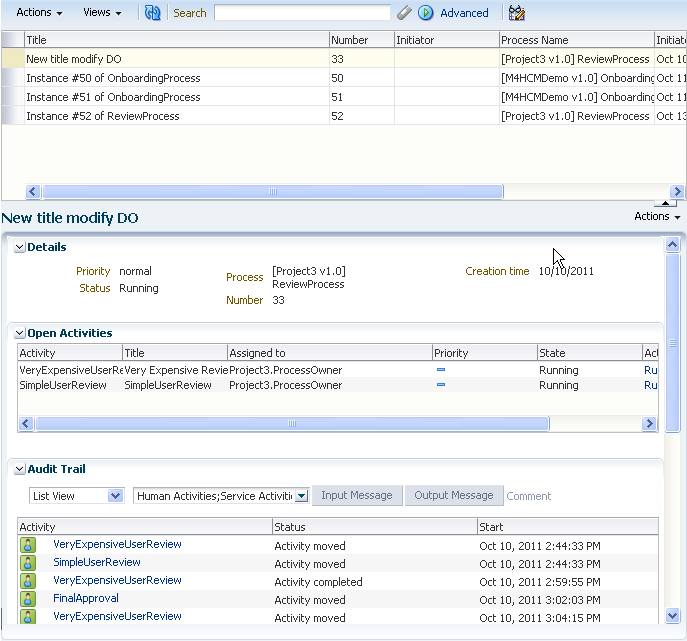
Description of "Figure 1-19 Process Workspace Process Tracking Page"
The Process Tracking page has these sections:
-
The Applications panel, which shows the list of applications available to you. Here you can perform basic Process Workspace actions, such as creating a new instance performing a given activity, or sorting applications.
Hovering over the name of an application in the Applications panel displays a tool tip with the application's full name and revision number.
The applications available in Process Workspace depend on the process design and the roles assigned to the user currently logged in. The list of available applications also depends on the BPM processes that are deployed and running. If no processes are running, or if you are not a participant able to execute an application in any of the processes currently running, then the applications panel is empty.
In the applications panel, you can sort either of the following:
-
Only the default versions of applications
-
All active versions of applications
You can sort either by name or by process version. You can filter the same applications by entering in the Search field either full or partial names or full or partial versions.
-
-
The Views panel, on the lower left half, displays the views available to you in an expandable tree
-
The Pending Components panel shows all suspended processes. If a new version of a process is deployed, and the previously deployed process has instances not yet migrated to the new version, then the previously deployed process is suspended. To resume it, either migrate or suspend any non-migrated instances. For information about resuming suspended processes, see Oracle Fusion Middleware Modeling and Implementation Guide for Oracle Business Process Management, "Resuming a Suspended Process".
-
The Work Items panel, on the upper right half, shows the task items corresponding to the view you have selected in the Views panel. In this panel, you can choose the columns that are presented in a given view. A particular column arrangement is known as a presentation. Clicking Add/Remove columns displays the Presentation dialog box in which you can define columns.
The following columns are available:
-
Actions
-
Activity
-
Activity Due Date
-
Copy
-
Creation Time
-
Deadline
-
Description
-
Has Attachments
-
Has Notes
-
Initiated
-
Initiator
-
Initiator Name
-
Instance #
-
Parent Copy
-
Participant
-
poID
-
Priority
-
Process Name
-
Process Due Date
-
Received
-
Status
-
Task Participant (that is, the participant that is currently executing an instance.)
-
Title
-
-
The Work Item Detail panel, on the lower right half, shows detailed information about a work item that you have selected in the Work Items panel. It has these sections:
-
Details: Shows the priority, process name, when the instance is due to complete, status, creation time, and the assignee if any.
-
Open Activities: Shows the status of any gateways with threads that are still running.
-
Audit Trail: Shows audit details in either a list view, a tree view, or graphical view. You can select the type of activity or sub-process you want to audit: human activities, service activities business rule activities, subprocesses, events, gateways, script activities, other activities, or all of the above.
If the process includes an input or output payload, then you can display the audit details for that message in a pop-up. Clicking on a particular activity displays the task history.
For more information about viewing audit details, see Section 3.3.1, "Viewing the Audit Trail in Process Workspace."
-
Comments: Enables you to add Comments to the process instance.
-
Attachments: Enables you to add attachments to the process instance.
For more information about adding comments and attachments to a process instance, see Section 3.3.2, "Associating Comments and Attachments with a Process Instance in Process Workspace."
-
1.3.4 About the Process Workspace Standard Dashboards Page
Dashboards provide analytical information to monitor process execution as well as user workloads. They provide summary information and enable you to drill down to instance-specific information.
Figure 1-20 shows the Standard Dashboards page.
Figure 1-20 Process Workspace Standard Dashboards Page
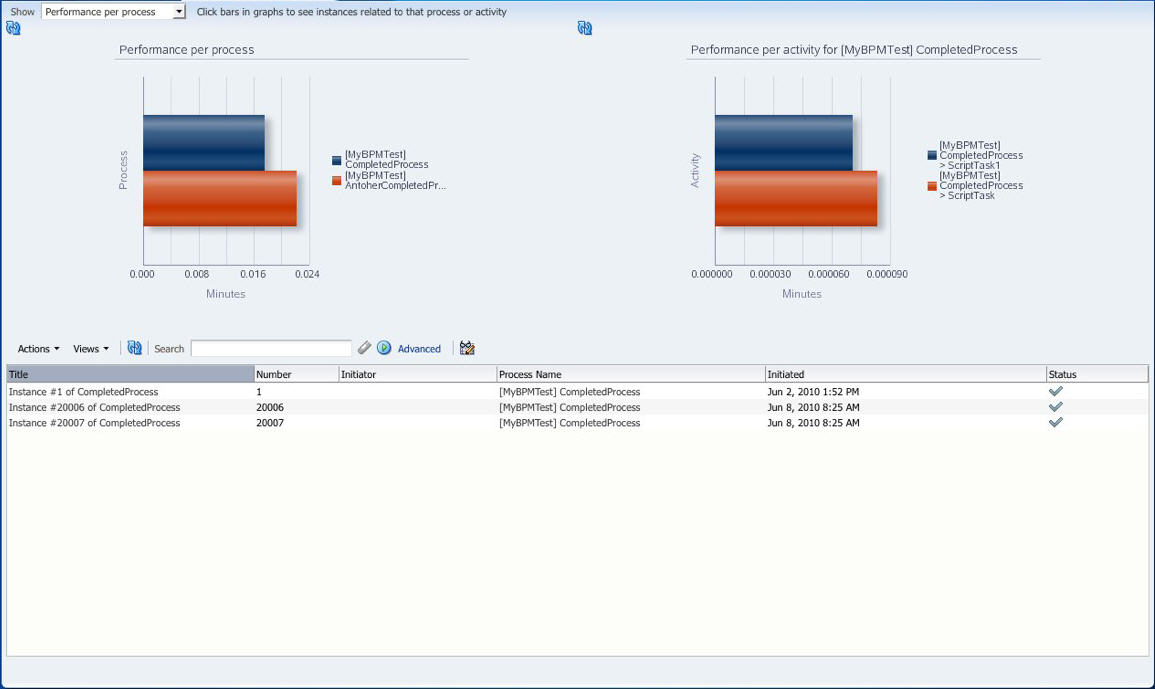
Description of "Figure 1-20 Process Workspace Standard Dashboards Page"
For additional information about dashboards, see Chapter 6, "Using Dashboards in Process Workspace".
1.4 Setting Accessibility Preferences in Process Workspace
To set accessibility preferences:
-
In the upper right corner of Process Workspace, click Preferences.
-
In the Configuration Areas panel, select Accessibility. The Select Accessibility page appears in the right pane as shown in Figure 1-21.
-
Select your accessibility preferences, then click OK.
1.5 Providing a Digital Certificate in Process Workspace
A digital certificate establishes the participant's credentials. It is issued by a certification authority (CA). It contains your name, a serial number, expiration dates, a copy of the certificate holder's public key (used for encrypting messages and digital signatures), and the digital signature of the certificate-issuing authority so that a recipient can verify that the certificate is real.
To provide a digital certificate:
-
In the upper right corner of Process Workspace, click Preferences.
-
In the navigation bar on the left, click Certificates.
-
Upload the certificate to use to sign your decision, as shown in Figure 1-22.
When signing a task outcome using your certificate, you must upload the entire chain of certificates through Process Workspace as a
.P7B(PKCS7 format) file, not just the one certificate issued to you by the certificate issuer. The entire chain can be exported through Internet Explorer. Mozilla Firefox does not let you export the chain as a.P7Bfile. Therefore, you can perform the following steps:-
Export the chain from Mozilla Firefox as a
.P12file (PKCS12 format that also contains your private key). -
Import the
.P12file in Internet Explorer. -
Export it again from Internet Explorer as a
.P7Bfile. -
Upload it through Process Workspace.
Note the following important points when providing your certificate to the system. Otherwise, you cannot use your certificate to sign your decisions on tasks.
-
The PKCS7 file format is a binary certificate format. Select this option if you have a standalone certificate file stored on your disk.
-
The PKCS12 file format is a keystore format. Select this option if you have your certificate stored inside a keystore.
-
If you want to copy and paste the contents of the certificate, select Type or Paste Certificate Contents and paste the BASE64-encoded text into the field. Do not paste a certificate in any other format into this field. Likewise, if you choose to upload a certificate, do not upload a BASE64-encoded certificate. Only PKCS12- and PKCS7- formatted files are supported for uploads.
-
-
Return to the task list by clicking the Home link in the upper right corner of Process Workspace.
-
Click a task to approve or reject.
The task details are displayed.
-
Click either Approve or Reject.
Details about the digital signature are displayed.
-
For a task that has a signature policy, click Sign.
The Text Signing Report dialog box appears.
-
Select the certificate from the list to use to sign your decision.
-
Enter the master password of the Web browser that you are using.
-
Click OK.
The Web browser signs the string displayed in the upper half of the Text Signing Request with the certificate you selected and invokes the action (approval or rejection) that you selected. The task status is appropriately updated in the human workflow service.
If you are a developer and want more information about how certificates are uploaded and used, see Oracle Fusion Middleware Developer's Guide for Oracle SOA Suite.
1.6 Accessing Administration Capabilities
The upper right toolbar contains an Administration link that takes you to the Administration Areas.
Table 1-9 lists and describes the categories in the Administration Areas and tells where to find more information about each one.
Table 1-9 Categories in the Administration Areas
| Category | Description | Information |
|---|---|---|
|
Organization |
Model an organization by defining organization units, business calendars, business holidays, roles, and other user properties. Note: If you are logged into Process Workspace, and changes are made to your organizational membership, you will not see these changes reflected in the interface until you log out and log back in again. This is because, for better performance, the organization unit information is cached when you log into Process Workspace. |
Section 10, "Managing Your Organization in Process Workspace" |
|
Flex Fields (Mapped Attributes) |
Create mappings needed for populating mapped attributes. |
Section 9.4, "Managing Mapped Attributes (Flex Fields) in Process Workspace" |
|
Task Administration |
Administer approval groups, task configuration, evidence search, and exceptions |
Section 9.5, "Using Task Configuration in Process Workspace" |
|
Application Preferences |
Customize the appearance of the worklist. |
Section 9.2, "Setting the Display of the Work Items Panel in Process Workspace" |
|
Specify your preferred language and time zone. |
Section 9.2.3, "How to Specify the Language Locale Information in Process Workspace" |
1.7 Setting Your Preferences in Process Workspace
The upper right toolbar contains a Preferences link.
Table 1-10 lists and describes the preferences you can set and tells you where to find information for setting each preference.
| Preference | Description | Information |
|---|---|---|
|
Provide a digital certificate from a certification authority to verify your credentials. |
Section 1.5, "Providing a Digital Certificate in Process Workspace". |
|
|
Set rules for tasks assigned to a user or group. |
Section 2.6.1, "How to Create User Rules in Process Workspace" Section 2.6.2, "How to Create Group Rules in Process Workspace" |
|
|
Setting notification preferences |
Configure the notification settings to control how, when, and where you receive messages in cases when you have access to multiple communication channels (delivery types). |
|
|
Setting accessibility preferences |
Select accessibility preferences such as using a screen reader, using high contrast colors, and large fonts. |
Section 1.4, "Setting Accessibility Preferences in Process Workspace" |
In addition to the preferences mentioned in this section, administrators can also set various preferences for how the Work Items panel is displayed in Process Workspace. For information about setting these application preferences, see Section 9.2, "Setting the Display of the Work Items Panel in Process Workspace".
